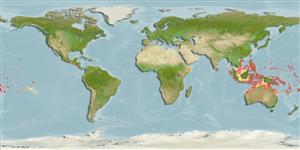Actinopterygii (ray-finned fishes) >
Perciformes (Perch-likes) >
Malacanthidae (Tilefishes) > Malacanthinae
Etymology: Hoplolatilus: Greek, hoplon = weapon + Latin, latus = wide (Ref. 45335). More on author: Randall.
Environment / Climate / Range
Ecology
Marine; reef-associated; depth range 20 - 105 m (Ref. 9710), usually 20 - 50 m (Ref. 27115). Tropical; 21°C - 26°C (Ref. 27115), preferred ?; 19°N - 23°S
Indo Pacific: Bali, Indonesia, the Philippines to Timor, north to the Mariana Islands, south to Rowley Shoals and New Caledonia; throughout Micronesia. Range extends to Pitcairn (Ref. 9710).
Size / Weight / Age
Maturity: Lm ? range ? - ? cm
Max length : 15.5 cm TL male/unsexed; (Ref. 90102)
Inhabits patches of talus or rubble of steep outer reef slopes. Usually seen in pairs that quickly dive headfirst into their burrow when disturbed. Juveniles occasionally school with similarly colored juveniles of Pseudanthias pascalus. Stomach contents of 6 adult specimens consisted of copepods (31.4% by volume), pelagic tunicates (31%, larvaceans, plus Oikopleura), fish eggs (28.6%), siphonophores (5.5%), larval shrimps (1.2%), fish (0.8%), amphipods (0.7%), unidentified decapod larvae (0.5%), and heteropods (0.3) (Ref. 8991). Minimum depth reported from Ref. 27115.
Life cycle and mating behavior
Maturity | Reproduction | Spawning | Eggs | Fecundity | Larvae
Randall, J.E. and J.K. Dooley, 1974. Revision of the Indo-Pacific branchiostegid fish genus Hoplolatilus, with descriptions of two new species. Copeia 1974(2):457-471. (Ref. 9870)
IUCN Red List Status (Ref. 115185)
CITES (Ref. 94142)
Not Evaluated
Threat to humans
Harmless
Human uses
Aquarium: commercial
More information
Common namesSynonymsMetabolismPredatorsEcotoxicologyReproductionMaturitySpawningFecundityEggsEgg development
ReferencesAquacultureAquaculture profileStrainsGeneticsAllele frequenciesHeritabilityDiseasesProcessingMass conversion
Tools
Special reports
Download XML
Internet sources
